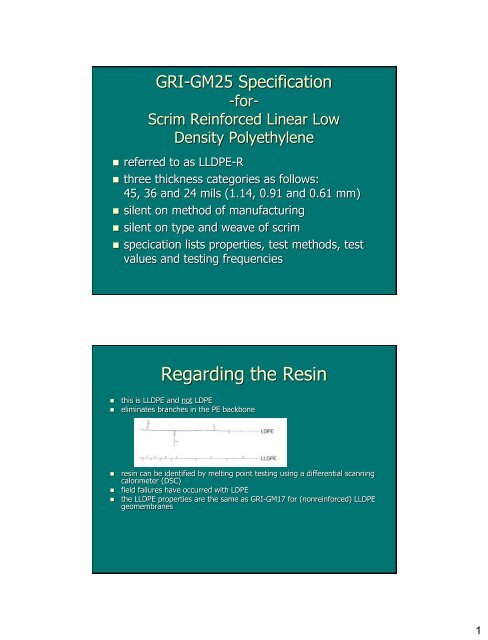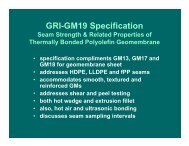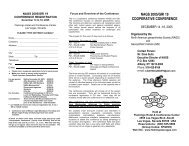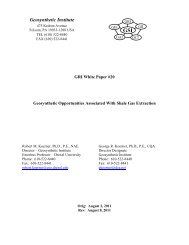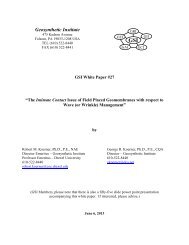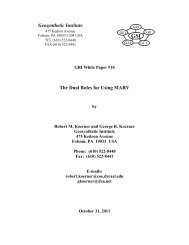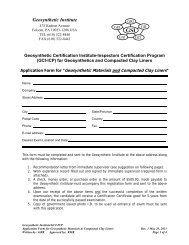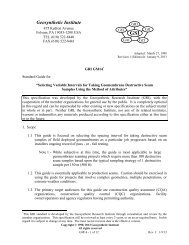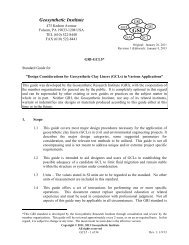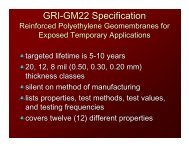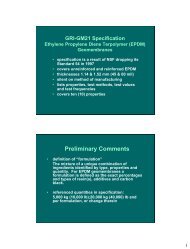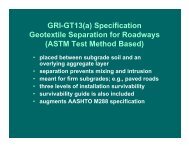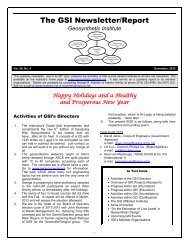Power Point Tutorial - The Geosynthetic Institute
Power Point Tutorial - The Geosynthetic Institute
Power Point Tutorial - The Geosynthetic Institute
Create successful ePaper yourself
Turn your PDF publications into a flip-book with our unique Google optimized e-Paper software.
GRI-GM25 Specification<br />
-for-<br />
Scrim Reinforced Linear Low<br />
Density Polyethylene<br />
• referred to as LLDPE-R<br />
• three thickness categories as follows:<br />
45, 36 and 24 mils (1.14, 0.91 and 0.61 mm)<br />
• silent on method of manufacturing<br />
• silent on type and weave of scrim<br />
• specication lists properties, test methods, test<br />
values and testing frequencies<br />
Regarding the Resin<br />
• this is LLDPE and not LDPE<br />
• eliminates branches in the PE backbone<br />
• resin can be identified by melting point testing using a differential scanning<br />
calorimeter (DSC)<br />
• field failures have occurred with LDPE<br />
• the LLDPE properties are the same as GRI-GM17 for (nonreinforced) LLDPE<br />
geomembranes<br />
1
Regarding the Categories<br />
• three are listed; 1-severe, 2-moderate and<br />
3-standard<br />
• they are admittedly subjective<br />
• meant to reflect type of handling,<br />
subgrade, backfill type and placement (if<br />
any), trafficking, equipment and<br />
maintenance<br />
Required Material Properties<br />
Physical Properties<br />
1. thickness<br />
2. weight<br />
Mechanical Properties<br />
3. grab strength<br />
4. grab elongation<br />
Endurance Properties<br />
8. OIT<br />
5. tongue tear<br />
6. index puncture<br />
7. ply adhesion<br />
9. OIT after oven aging<br />
10. OIT after UV incubation<br />
2
1. Thickness<br />
• follows ASTM D5199<br />
• dead weight micrometer with flat tip<br />
• measurement includes the scrim<br />
• 10-specimens across roll width<br />
• average must equal nominal<br />
• min. ave. values are listed<br />
• required for each roll<br />
ASTM D5199<br />
Thickness Test<br />
3
2. Weight<br />
• correct term is mass per unit area<br />
• follows ASTM D5261<br />
• five specimens across roll width<br />
• values averaged and compared to spec<br />
value stated as “min. ave.”<br />
• required for each roll<br />
ASTM D5261<br />
Mass/Unit Area<br />
(Weight) Test<br />
4
3&4: Grab Tensile Strength and<br />
Elongation<br />
• follows ASTM D7004<br />
• 4 in. (100 mm) wide specimen grabbed in<br />
the central 1 in. (25 mm)<br />
• data reported in lb (or N), not lb/in. (or<br />
N/m)<br />
• min. ave. of both 5 MD and 5 XMD<br />
• every 30,000 lb (15,000 kg)<br />
ASTM D7004 – Grab Tensile Test (Measures Strength and Elongation)<br />
5
5. Tongue Tear Test<br />
• uses ASTM D5884<br />
• specimen 8 4 with 3 in. slit<br />
(200 100 with 75 mm slit)<br />
• speed is 2.0 in./min (50<br />
mm/min)<br />
• average of 5MD and 5XMD<br />
• every 30,000 lb (15,000 kg)<br />
D5884<br />
Tongue Tear<br />
6
6. Puncture Resistance<br />
• follows ASTM D4833<br />
• called “pin” puncture<br />
• min. ave. of 15-tests<br />
• 380, 330, 290 N (85, 75, 65 lb)<br />
• every 15,000 kg (30,000 lb) ~ 25<br />
rolls<br />
D4833<br />
“Pin”<br />
Puncture Test<br />
7
7. Ply Adhesion<br />
• follows ASTM D6636<br />
• min. ave. of 5 longitudinal tests<br />
• requires 20 lb (9 N) min. ave.<br />
• required every 30,000 lb (15,000 kg)<br />
Ply Adhesion per ASTM D6636<br />
8
8. Oxidative Induction Time<br />
• OIT is an indirect measurement of the amount of antioxidants<br />
Item Standard High Pressure<br />
ASTM D3985 D5885<br />
Specimen ~ 2 mg ~ 2 mg<br />
Pressure<br />
35 kPa<br />
(5 lb/in 2 )<br />
3500 kPa<br />
(500 lb/in 2 )<br />
Temperature 200°C in N 2 ;<br />
1 min. dwell;<br />
switch to 0 2<br />
150°C to N 2 ;<br />
1 min. dwell;<br />
switch to 0 2<br />
Spec Value 100 min. 400 min.<br />
• challenges the amount and type of antioxidants (AO’s)<br />
• frequency is each formulation<br />
High Pressure (Left) and Standard (Right) Cells for Measuring OIT<br />
9
Standard OIT (ASTM D3895)<br />
HP-OIT (ASTM D5885)<br />
On choice of Std. or HP-OIT<br />
Phosphites<br />
Hindered<br />
Phenols<br />
Thiosynergists<br />
Hindered<br />
Amines<br />
0 50 100 150 200 250 300<br />
(Ref. Fay and King, 1994)<br />
• Std-OIT misrepresents AO packages with thiosynergists and/or hindered amines<br />
• HP-OIT is always applicable (but $10,000 cell and longer test time)<br />
10
9. Oven Aging<br />
• challenges the thermal stability of<br />
antioxidants (AOs), i.e., type of AO’s<br />
• follows ASTM D5721<br />
• forced air oven at 85°C<br />
• Std.-OIT 35% ret. after 90 days<br />
exposure … “or” …<br />
• HP-OIT 60% ret. after 90 days<br />
• frequency is per formulation<br />
D5721<br />
Forced Air<br />
Oven<br />
11
10. Ultraviolet Resistance<br />
• challenges the UV stability of the AOs and CB<br />
(there should be synergy), i.e., type of AO’s<br />
• uses a laboratory weatherometer<br />
• follows ASTM D7238<br />
• called “ultraviolet fluorescent device”<br />
• 20 hr. UV cycle at 75°C, then 4 hr. condensation<br />
at 60°C<br />
• HP-OIT 35% ret. after 1600 hrs.<br />
• frequency is per formulation<br />
ASTM D7238<br />
Ultraviolet<br />
Fluorescent<br />
Weatherometer<br />
12
Concluding Comments<br />
• spec addresses scrim reinforced LLDPE-R<br />
• resin/formulation is complimentary to<br />
GM17 for unreinforced fPP<br />
• physical and mechanical properties are<br />
obviously different<br />
• endurance properties are the same<br />
• this is an MQC specification; if<br />
manufacturer’s QC is more stringent use<br />
it, if not use this specification<br />
<strong>The</strong> Basic Tables Follow<br />
1(a) – U.S. Standard Units<br />
1(b) – SI (Metric) Units<br />
Note: <strong>The</strong> most recent version of this<br />
specification (text and tables) is on<br />
the GSI Website at<br />
http://www.geosynthetic-institute.org/specifications.htm<br />
13


